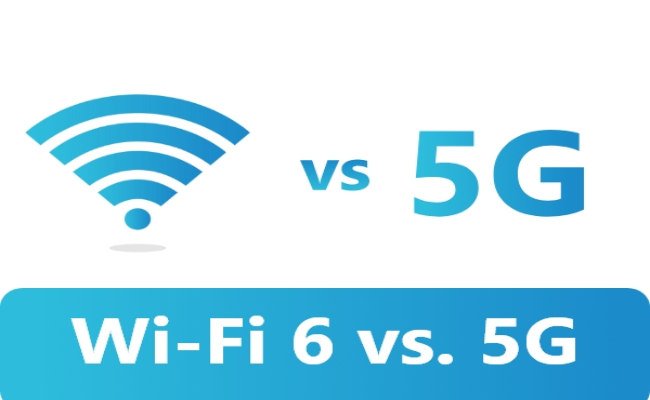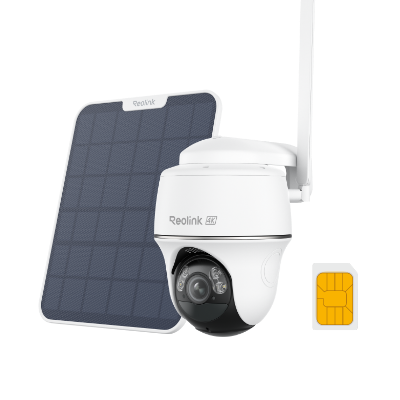WiFi 6 vs. 5G: Exploring The Differences

In today’s connected world, the question of WiFi 6 vs 5G is becoming increasingly relevant. Both are being hailed as the next big thing in wireless technology, promising faster speeds, lower latency, and a more seamless user experience.
The convergence of 5G vs WiFi 6 is shaping the future of connectivity, each offering unique capabilities that complement one another. Understanding the main difference between 5G and WiFi 6 is crucial for businesses and consumers alike. Both have their respective merits and are set to revolutionize the way we connect and communicate.
5G vs. WiFi 6 Comparison: Key Differences
The primary difference between 5G vs WiFi 6 is that 5G is essentially a mobile communication technology developed for cellular networks while WiFi 6 is a local wireless area network aiding wireless communication in a particular locale.
Let’s explore the other key differences between the two.
Speed
When it comes to 5G vs. WiFi 6 speed, both technologies promise significant improvements over their predecessors. WiFi 6 offers speeds up to 9.6 Gbps, compared to the 3.5 Gbps of WiFi 5.
On the other hand, 5G networks can theoretically reach up to 10 Gbps, making the 5G vs Wi-Fi 6 speed comparison a tight race.
Purpose
In terms of purpose, there's a clear distinction. Private 5G vs WiFi 6 sees the former being more suitable for personal usage, while the latter is designed for public use in more extensive settings like airports and stadiums.
Infrastructure
The 5G vs. WiFi 6 infrastructure debate reveals another critical difference. WiFi 6 relies on routers and access points, while 5G uses a network of towers and data stations spread across the city.
Coverage Range
When comparing WiFi 6 vs 5G in terms of coverage range, WiFi 6 covers smaller areas like homes, offices, or specific zones; 5G, however, provides broader coverage, reaching throughout the city and even extending to rural and remote areas.
Security
In terms of Wi-Fi 6 vs 5G reliability, both employ different security measures. While WiFi 6 uses WPA3 protocol for enhanced security, 5G has robust security features built into its network architecture.
Cost
The 5G vs Wi-Fi 6 cost comparison is influenced by various factors, such as infrastructure requirements, service plans, and device compatibility. While WiFi 6 can be a one-time investment for homes and businesses, 5G often involves ongoing costs related to data plans and network usage.
WiFi 6 vs. 5G: Comparison Table
To better understand the differences between 5G and WiFi 6, let's take a look at a comparison table. This table highlights their critical distinctions in areas such as speed, purpose, infrastructure, range, security, and cost.
5G vs. WiFi 6: Use Cases
In today's digital age, the primary use cases of 5G vs. WiFi 6 is becoming increasingly relevant. Both technologies offer unique advantages that cater to different needs and scenarios. Let's explore the specifics of how 5G cellular vs WiFi 6 is typically utilized in various contexts.
WiFi 6 Use Cases
WiFi 6, being designed for high-density environments, has several use cases:
- Home Networks: With the proliferation of smart home devices, Wi-Fi 6 provides the needed bandwidth and efficiency to handle multiple devices simultaneously.
- Offices And Co-Working Spaces: Wi-Fi 6 can accommodate the high demand for connected devices, providing stable connections for video conferencing, large file transfers, and cloud-based applications.
- Public Venues: In places like stadiums, airports, and shopping malls where hundreds or thousands of devices might be trying to connect to the network, Wi-Fi 6 ensures a smoother and more efficient connectivity experience.
5G Use Cases
5G, on the other hand, is set to revolutionize a broad spectrum of industries with its ultra-fast speeds and low latency:
- Autonomous Vehicles: 5G's low latency is crucial for autonomous vehicles, enabling real-time communication between vehicles and infrastructure.
- Smart Cities: From traffic management to energy conservation, 5G will play an integral role in enabling innovative city initiatives.
- Remote Work And Learning: 5G can provide reliable, high-speed connections necessary for video conferencing and data-intensive tasks, making remote work and learning more feasible and efficient.
- Healthcare: 5G could transform healthcare by enabling telemedicine, remote patient monitoring, and advanced AI capabilities.
By understanding these use cases, we can better appreciate the unique strengths of WiFi 6 vs 5G and how they can complement each other in different scenarios.
Is 5G Faster Than Wi-Fi?
The answer to whether 5G is faster than Wi-Fi is a complex one, as it depends on various factors. In terms of raw speed potential, both 5G and Wi-Fi 6 can offer similar speeds, with 5G theoretically capable of reaching up to 10 Gbps and Wi-Fi 6 up to 9.6 Gbps.
The speed that users actually experience can differ significantly depending on factors such as network infrastructure, the number of connected devices, distance from the source, and interference.
Generally, in an ideal setup, 5G provides faster speeds, especially in outdoor settings. Conversely, Wi-Fi 6 could offer faster speeds in indoor scenarios where the router is close by and there's less interference.
Basics Of WiFi 6 And 5G
Understanding the basics of Wi-Fi 6 and 5G can help us comprehend their capabilities and how they are reshaping our digital world. Let's delve into the fundamental definitions of these two technologies.
What Is WiFi 6?
When asked what is WiFi 6, it refers to the latest standard of Wi-Fi, also known as 802.11ax. It's a significant upgrade over its predecessor, Wi-Fi 5 (802.11ac), designed to improve speed, increase efficiency, and reduce congestion in heavy bandwidth usage scenarios.
It achieves this by using technologies like OFDMA (Orthogonal Frequency Division Multiple Access) for better data distribution and MU-MIMO (Multi-User, Multiple Input, Multiple Output) for improved capacity.
What Is 5G?
When asked what is 5G, it is the fifth generation of cellular network technology that promises faster data speeds, lower latency, and improved flexibility compared to its predecessor, 4G.
It's not just about speed but also about creating a more connected world. Unlike 6G vs 5G, where 6G is still largely theoretical, 5G is already being deployed and used around the world.
5G uses a range of frequencies, from low-band spectrum (below 1 GHz) for broad coverage, mid-band spectrum (1-6 GHz) for a balance of speed and coverage, to high-band spectrum (above 24 GHz) for high-speed data transfer in dense urban areas.
WiFi 6 vs. 5G In Security Cameras: Which Offers Better Connectivity?
In the realm of security cameras, both WiFi 6 and 5G have made their mark, offering enhanced connectivity options. WiFi 6 excels in high-density environments such as malls or office buildings, providing higher speeds and increased capacity for simultaneous device connections. It also uses WPA3, offering secure communication methods.
Conversely, 5G shines when broad geographic coverage is necessary. With low latency and fast data transfer, 5G enables real-time monitoring and response, which is critical for security camera systems. Its superior privacy and default security make it an ideal choice for sensitive installations.
WiFi 6 Security Camera
Integrating WiFi 6 technology into security cameras offers a more reliable surveillance solution. A WiFi 6 camera boasts improved connectivity, reduced interference in crowded environments, and higher data transfer speeds.
It also provides lower latency for real-time monitoring, better range and coverage, compatibility with older Wi-Fi versions, and enhanced security features. The ability of a WiFi 6 security camera to handle multiple connected devices and offer seamless 4K or 8K video streaming makes it an ideal choice for modern surveillance needs.
For instance, Reolink provides a range of Wi-Fi 6 security cameras like the Reolink E1 Outdoor Pro and the RLK12-800WB4 security camera kit.
4K WiFi PTZ Camera with Auto-Tracking
4K 8MP Super HD, Smart Person/Vehicle Alerts, 355° Pan & 50° Tilt & 3X Optical Zoom, Auto Tracking, Color Night Vision.
5G Security Camera
The emergence of 5G security cameras marks a new era in surveillance technology. However, this technology is still evolving, and users may need to wait for further advancements before considering their adoption.
As an alternative, users can consider using 3G/4G cellular cameras, which utilize cellular networks for connectivity and can provide reliable surveillance in areas where Wi-Fi or wired connections are not available.
The future of 5G wireless security cameras holds promise, but currently, it's advisable to explore other robust and readily available options for surveillance needs. For example, the Reolink Go PT Ultra, a 4G cellular security camera.
4K 8MP Wire-Free 4G LTE PT Battery Camera
4K 8MP; Smart Detection; 355° Pan & 140° Tilt; Battery/Solar Powered; Color Night Vision; Smart Real-Time Alert.
FAQs
Which One Should I Choose, 5G or Regular WiFi?
The choice between 5G and regular Wi-Fi depends on your specific needs. If you need connectivity over a larger geographic area and require low latency, 5G is a better choice. However, for high-density environments with multiple devices, regular Wi-Fi, especially Wi-Fi 6, could be more suitable.
What's The Main Difference Between WiFi 5 And WiFi 6?
The main difference lies in speed and capacity. Wi-Fi 6 offers faster data transfer rates and can handle more simultaneous connections than Wi-Fi 5, making it ideal for high-density environments.
Is 5G Better Than Wi-Fi?
Neither is inherently "better". 5G offers broader coverage and lower latency, making it ideal for real-time applications. Wi-Fi, particularly Wi-Fi 6, is excellent for high-density environments and offers higher data transfer speeds.
Conclusion
In the debate of 5G vs WiFi 6, both offer unique advantages. 5G provides broader geographic coverage and low latency, making it ideal for real-time applications.
On the other hand, Wi-Fi 6, operating over an unlicensed spectrum, offers high-speed connectivity and supports multiple devices in high-density environments. Hence, neither is inherently superior; the choice depends on specific user needs. Which one would you like to choose, WiFi 6 or 5G? Tell us your thoughts in the comment section below! Let's discuss together!
Search
Subscribe for the Latest Updates
Security insights & offers right into your inbox


